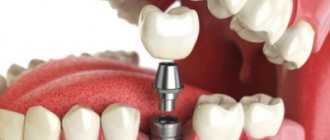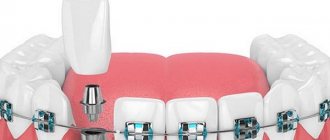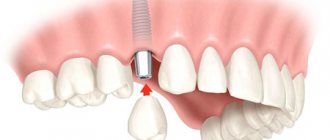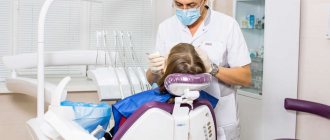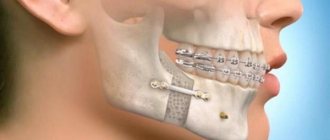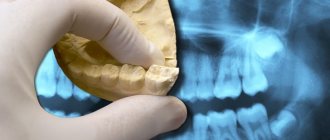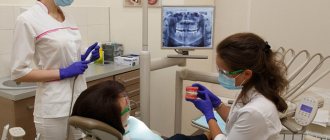An orthodontist is a person who deals with the correction and elimination of anomalies of the dental system. It is to him that people turn to with similar problems: a protruding jaw, a too narrow chin, crooked incisors, etc. Such a specialist takes on congenital, acquired in childhood and hereditary defects. Moreover, he can work with patients of any age.
Some people believe that correcting the abnormal position of teeth can only be done in childhood. This is wrong. In a child, the treatment process is simpler, but a congenital or hereditary problem can develop in adulthood or worsen over time. If this happens, do not hesitate to contact your doctor.
Why do they put braces?
Bracket is a bracket translated from English. Indeed, the main structural unit of modern brace systems is an arch (bracket) made of steel or various alloys. In general, it is a non-removable structure consisting of clasps glued to the teeth with special glue, through which the orthodontic arch passes. The arch is firmly fixed and is the main force that gradually aligns the dentition. It is tied to the dentition with threads or rubber rings - ligatures and secured to the molars with special metal rings. Depending on the degree of dentition disturbance, the arch is given a certain degree of tension.
To correctly place braces, the orthodontist can increase or decrease the degree of tension by changing the arch: the thicker it is, the stronger the tension.
Braces were invented at the beginning of the last century. Their design was constantly improved, new types were created, but the principle of their operation remained the same. The popularity of the method is steadily growing, especially in the modern world, where a smile plays such a big role in the life of every person. Restoring the dentition and bite reduces the risk of developing inflammatory and degenerative-dystrophic diseases of the periodontal tissues (periodontitis, periodontal disease) and premature tooth destruction.
At what age do orthodontists become pros?
If you think that an orthodontist for 40 years is very experienced, let's be honest, this is absolutely unknown. In modern orthodontics, age is no longer given importance, because modern orthodontics is the orthodontics of the millennial generation or slightly older - from 25 to 40 years old. The reason for this is that earlier education took place at a different time in conditions of a lack of information, and not everyone was ready to constantly improve their knowledge. Now orthodontics is based on scientific data, there is much more information, more private education and seminars have appeared, where doctors of above average age rarely go, and younger doctors are already accustomed to studying regularly, it is important for them to try and know the latest technologies.
Who should get braces?
Installation of a brace system is recommended in the following cases:
- For malocclusion - the correct closure of the teeth of the upper and lower jaws in children, adolescents and adults. Such violations occur very often, but in most cases they are invisible to the person himself and others. Severe malocclusions not only prevent a person from chewing food, but also cause speech disorders and an unattractive appearance.
- In case of an anomaly in the position of individual teeth: deviation of them outward or inward from the dentition, high or low position, gaps between the central incisors, rotation of the teeth around an axis, crowding in the dentition. All these anomalies are easily eliminated with braces.
- In the presence of unerupted (impacted) teeth. Most often these are the upper canines, lower wisdom teeth and small molars. Retention is associated with a lack of space in the dentition due to premature removal of baby teeth or improper development of the jaw. Installing a braces system allows you to expand the interdental spaces and allow impacted teeth to take their place in the dentition.
- If necessary, corpus movement of the teeth - simultaneous displacement of the crown and root to one side.
- If it is necessary to improve the appearance of the face, profile correction.
- In the process of preparing for prosthetics or dental implantation to expand the interdental space (in case of bone tissue atrophy due to long-term absence of a tooth).
Which doctor puts braces?
The installation of the braces system is carried out by an orthodontist. The tasks of this specialist include identifying and eliminating anomalies of the dental system and preventing complications associated with them. Such complications include disorders of chewing, speech, changes in facial configuration and other cosmetic defects. Malocclusion and other dental anomalies make oral hygiene difficult: due to the inability to remove plaque in hard-to-reach places, the risk of developing caries and periodontal disease increases. The work of the chewing and facial muscles of the maxillofacial area, the temporomandibular joints is disrupted, and the teeth become mobile.
Dental anomalies are mainly a congenital pathology, so the orthodontist more often has to deal with children and adolescents. But in recent years, the percentage of adult patients turning to an orthodontist has increased significantly.
An orthodontist corrects dental anomalies using removable and non-removable devices. The most famous and widely used fixed device in orthodontics is braces.
When is the best time to get braces for children?
If parents see that the child has a clearly broken bite or has some other dental anomalies, then the first visit to the orthodontist should be at the age of 3-4 years, when the baby teeth have completely erupted. But it is too early to put on braces at this age: they are heavy for baby teeth, so they will interfere with blood circulation in the dentofacial area and slow down the eruption of permanent teeth. The risk of enamel changes due to its insufficient mineralization in young children also increases. For such children, the doctor prescribes wearing special plates.
The optimal age for installing braces on teeth is 12 – 14 years. Usually by this age all permanent teeth, including molars, have erupted. At the same time, the dental system continues to develop and is easily corrected.
It is best to get braces for children between the ages of 12 and 14.
Is it possible to get braces if you have fillings or crowns?
Such problems usually occur in adult patients, since teeth decay in children and adolescents much less frequently. If you have a properly treated and filled tooth, installing a brace system is not contraindicated.
If you have artificial crowns, the issue of installing braces will be decided individually. It all depends on the material from which the crown is made: how firmly the glued structure will adhere to it.
Is it possible to get braces after dental implantation? They don't usually do that. If any correction of the dentition is required, it is carried out first and only after that is implantation possible. But sometimes the implant is a support on which a ring securing the system is installed.
Stages of treatment by an orthodontist
At the beginning of treatment, the specialist conducts a diagnosis, which largely determines the final result.
The patient goes through the following stages:
- Visual inspection. The doctor studies the symmetry of the face, shape, profile and features of the oral cavity. An assessment is made of the general appearance of the teeth and jaws. The movement of the jaw and the closure of teeth are studied. The examination helps to identify how severely the bite is deformed and determine how difficult and long the treatment will be.
- An oral x-ray gives a general picture of the condition of the jaws and teeth. The image shows features that may not be noticed during normal examination.
- Making plaster models based on dental impressions taken. The model shows the location of the teeth, all the cusps and pits of the jaw. The specialist measures the necessary parameters and determines possible deviations. All features of the planned design must be taken into account at this stage.
Having determined the diagnosis, the specialist decides on a method to correct the problem:
- myotherapy - used only for small patients who are not allowed to have braces. Gymnastics of the jaws is carried out, during which children are given a correct bite that has not had time to form. The method cannot guarantee a 100% result. Gymnastics can also be used for adult patients when there are features that resist the use of other methods;
- hardware - used for patients of any age. For adults, the adjustment will take one to two years longer than for children. The procedure itself takes about an hour. The doctor installs braces, plates or aligners;
- surgical - used when there is no room in the mouth for teeth to grow or they are severely twisted.
Who should not get braces?
Installation of braces has contraindications:
- Absolute – it is not possible to eliminate them: complete absence of teeth (edentia) or the absence of a large number of them;
- changes in the bone tissue of the jaw, leading to its fragility - osteoporosis and osteochondropathy;
- severe diseases of the blood, cardiovascular, endocrine (diabetes mellitus) systems;
- oncological diseases;
- tuberculosis, AIDS;
- mental illness.
- infectious-inflammatory and degenerative-dystrophic diseases of periodontal tissues (periodontitis, periodontal disease);
After treatment of these diseases, braces can be installed.
Which braces are better to choose?
Currently, several types of systems are produced. You can choose the most suitable model for adults, teenagers and even children. The orthodontist and the patient decide which braces to install. Prices for individual types also vary: from inexpensive to VIP models. All models are divided according to the type of design, method of attachment to the teeth and material of manufacture.
By type of design
Based on this feature, there are two types of models:
- Ligature (classical) braces. In these models, the locks do not have caps, and the arch is fixed using special fasteners - ligatures. The advantage of these models is their ease of manufacture and inexpensive price. Disadvantages - difficulties during installation: the doctor must clearly calculate the force of the arch on the dentition and, at certain intervals, increase or decrease it, depending on how the treatment process is going. To achieve this, the patient must visit the orthodontist frequently. The treatment period may increase due to difficulties in calculating the force of impact on the dentition. Design features also make it difficult to maintain oral hygiene. The price, depending on the material of manufacture, is 30 - 45 thousand rubles.
- Non-ligating (self-ligating) braces. These designs have caps on the locks that secure the arc. The system has a gentler effect on the dentition and does not require constant correction by the orthodontist. Price from 25 – 30 thousand rubles. There are two types of non-ligature braces: active – the caps covering the locks have an active effect on the arch, increasing its strength in the desired direction;
- passive - lock covers do not affect the arc; this is a more modern type of braces; They are easy to install and there is no need to calculate the force on the arc.
Ligature and non-ligature braces
One of the most effective non-ligature passive models is the unique Damon System brace system, introduced into practice in 2000. This is a completely self-regulating, reliable system that acts gently and effectively, and does not require frequent monitoring by the orthodontist. Metal models are available (Damon Q - 80,000 rubles) and aesthetic, more expensive ones, made of transparent polycrystalline aluminum (Damon Clear - 90,000 rubles). Oral hygiene is easier with the Damon system than with other systems.
According to the method of attachment to teeth
The bracket system can be attached to the teeth in the following ways:
- The vestibular method is the most common; the clasps are attached to the front surface of the dental crowns. The system is reliable, time-tested, but its disadvantage is that it is not always aesthetically pleasing. This type of fastening is used mainly in the treatment of adolescents. The price of braces is from 10,000 to 60,000 rubles. depending on the material used.
- Lingual method - clasps are installed on the inner surface of the crowns facing the oral cavity. In such cases, braces are outwardly invisible, which is why they are preferred by adults. Disadvantages: These are more expensive models and after installation, speech problems may occur for some time. The price of lingual braces is from 100,000 rubles.
Vestibular and lingual braces
According to the material of manufacture
Bracket systems can be made from different materials:
- metal - the most common; made of titanium and some alloys with hypoallergenic properties; advantages: reliability of fastening, ensuring minimal duration of treatment and relatively low cost; cons – not very aesthetically pleasing, used mainly as braces for children and teenagers; price from 25,000 rubles;
- ceramic – locks are made of white hypoallergenic ceramics; the shade can be matched to the color of the patient’s teeth; advantages - almost invisible in the mouth; cons - less reliable and more expensive than metal ones; these braces are preferred by adults; price from 50,000 rubles;
- plastic – the locks are made of hypoallergenic plastic; advantages - lightweight, inexpensive designs; disadvantages - they break easily, are stained with food coloring and fail; most often used in pediatric orthodontics; price from 10,000 rubles;
- sapphire – made from transparent artificial sapphires; advantages - no less reliable than metal ones, have an aesthetic appearance; cons – high cost, from 60,000 rubles;
- combined - ceramic clasps are installed on the front teeth, metal clasps are installed on the side teeth; this reduces cost and improves reliability.
Types of braces by material
The process of installing braces for adults
The installation of braces takes place in several stages: preparation – installation – activation. The orthodontist tells the patient in detail how braces are placed before the procedure.
Preparation
Preparation for the procedure begins with a consultation with an orthodontist. Before installing braces, the doctor always carefully examines the patient and sends him for x-rays of the upper and lower jaws. After establishing the final diagnosis, he draws up a treatment plan. First of all, the sanitation of the oral cavity is carried out: all teeth subject to treatment are treated, those not subject to treatment are removed.
After this, an impression is taken of both jaws to make a plaster model of the jaw in a dental laboratory. The doctor, together with the patient, selects the most suitable bracket system in terms of design and price.
Stages of installing braces
The installation of braces on teeth is carried out strictly in accordance with the developed protocol. She may be:
- direct - the clasps are glued directly during installation to each crown;
- indirect - first a plaster model is made, the finished structure is assembled on its basis and immediately installed in the oral cavity; This method is faster and more efficient.
Installation steps:
- Installation of a labial and jaw retractor. These mouth expanders allow access to the dentition of the upper and lower jaw. The patient can completely relax.
- Cleaning and protecting teeth. The surface of the tooth crowns is thoroughly cleaned, polished and dried.
- Installation of locks. Using special cement, a clasp is glued to the surface of each tooth. The cement is dried with a lamp with ultraviolet radiation, and its remains are removed. Braces are installed first on the upper jaw, then on the lower jaw. Indirect installation allows installations to be carried out much faster.
- Installation of the arc. After the cement has hardened, an arch is pulled through each lock and secured using a ligature (using rubber bands) or non-ligature (snaps into the grooves of the locks) method. On the lateral abutment teeth (6 or 7), the system is secured using locking rings.
The entire process of installing braces is painless and takes no more than an hour.
Activation
After installing braces, under the action of the tension force created by the arch, the teeth gradually move in a given direction and change their position. As their position in the dentition changes, the tension force of the arch decreases. This condition requires correction, called braces activation. When installing classic ligature braces, the doctor adjusts the tension force once a month. With non-ligature braces, control is required much less frequently; the orthodontist individually decides how often control should be carried out.
How to tell if braces are installed correctly
This can only be determined by a qualified specialist who has experience installing various types of braces. Experienced specialists work in the St. Petersburg dental clinic “Yulistom”, this allows for high-quality installation of braces with complete elimination of the possibility of error.
How can you determine the professionalism of a doctor in the communication process and by what phrases?
At the Confidential Clinic, the criterion for an orthodontist’s professionalism is, among other things, the ability to speak with a patient in the patient’s language. A competent and experienced orthodontist is not one who speaks in terms alone, showing his awareness, but one who can understand what the patient’s problem is and, in an accessible language, tell the patient clearly and in detail about what is happening to him.
When I come across an area that is unfamiliar to me, and they still talk to me in their professional language, then I don’t feel like I’m communicating with the pros, because they can’t clearly translate the information into a language I understand.
M.S. Morozov, head of the orthodontic department of the Confidence clinic.
Installation of braces for children and adolescents
It is better to get braces at the age of 12-13 years, when all the permanent teeth have erupted. But in some cases, braces are placed at the age of 7-9 years, when the first permanent teeth erupt. To correct dental problems in children, the same types of braces and installation protocols are used as in adults.
In childhood and adolescence, correction occurs faster: if an adult needs several years to completely restore the normal state of the dentition, then in children this period is much shorter.
How many orthodontic treatment options or plans (with braces) does the doctor offer?
At the first consultation without diagnostic data, the orthodontist never offers more than two treatment plans. He can offer other options only after a full diagnosis. For example, options with or without deletion. The doctor does not describe them in full, so as not to promise the patient in advance a result that may not be applicable to a specific clinical case.
After a full diagnosis, the orthodontist can offer you up to three treatment plans for braces, each of which will take into account their pros and cons, the wishes and capabilities of the patient. It is always the patient who weighs all the options and makes the final decision. The orthodontist never imposes an orthodontic treatment plan because the patient must make a conscious choice in favor of braces treatment based on all the information provided to him.
Caring for braces after installation
After installing braces, the patient's body must get used to them. At first, they can rub the inner surface of the lips or tongue, causing pain, problems with taste and diction. But if you follow all the doctor’s recommendations, within 1 – 2 weeks after installing braces, your teeth will not hurt, all discomfort and speech disorders will disappear. The patient will simply stop perceiving braces as something foreign. If braces irritate the inner surface of the cheeks or lips, erosions and ulcers form on the mucous membrane, then, as prescribed by the doctor, the clasps are covered with special wax or silicone. A piece of wax is lightly kneaded in your hands and pressed into the lock, after cleaning and drying your teeth and braces.
Diet restrictions
For the first few weeks after installation of braces, it is recommended to eat only liquid and mushy foods. Gradually, dishes can be diversified. But it is better to grind solid foods first in a blender. It is also better not to consume very cold or very hot food and drinks. The following products will need to be completely eliminated while wearing braces:
- anything that sticks to the teeth - chewing candies (taffy, soft caramel), Turkish delight, nougat, chewing gum;
- everything that stains teeth - beets, red wine, strong black tea, coffee, Coca-Cola.
Limit: sweets and baked goods, as they are an excellent breeding ground for microorganisms present in the mouth.
How to brush teeth with braces
When starting to brush teeth with braces with a regular brush, the patient notices that it is impossible to do this efficiently. Therefore the following are produced:
- special toothbrushes with V-shaped bristles:
- cone-shaped (mono-beam) toothbrushes:
- interdental brushes:
- dental floss (floss); They come in different types depending on how closely the teeth are arranged in the dentition.
Such devices perfectly clean both teeth and braces. You should consult your dentist about which toothpaste is best to use. He will recommend the most suitable toothpaste for the patient.
You can also use irrigators to clean hard-to-reach places with a water jet. These devices do not injure the gums at all:
But even this will not be enough. If you have had braces installed, you should visit a dental hygienist at least twice a year for professional teeth cleaning.
Orthodontist visit schedule
The frequency of consultations depends on the type of braces installed. Classic ligature braces require a visit to the orthodontist to correct the tension of the arch once every 1.5 - 2 months. If ligature-free active braces are installed, the doctor may schedule less frequent visits. The easiest way to treat is with passive non-ligated Damon System braces. These are self-regulating systems, so recovery of disorders occurs faster and does not require frequent visits to the orthodontist.
If braces cause severe, increasing discomfort, you should immediately contact an orthodontist.
Indications for contacting an orthodontist
A visit to the orthodontist should be scheduled after the primary baby teeth appear—at 3-4 years of age. An early examination will help to identify pathology at the stage of formation of the dental system of a young patient, which will significantly facilitate and speed up treatment.
You should also schedule a mandatory visit to the orthodontist if you have:
- bad habits in a child - he will not part with the pacifier, constantly holds his thumb in his mouth, chews pencils and pens;
- mouth breathing - reluctance to breathe through the nose indicates orthodontic pathologies;
- obvious deviations in the development of the dentofacial apparatus - congenital or appearing as teeth grow or change;
- difficulties in swallowing, chewing;
- speech therapy problems, difficulties in pronouncing individual sounds;
- large interdental spaces;
- crowding.
When and how are braces removed?
The doctor decides when to remove braces. It depends on the:
- state of the dentition - a small degree of defect (one or two crooked teeth) is restored faster than complex malocclusions;
- the age of the patient - correction is most quickly carried out in adolescence; in adults this is a longer process;
- type of braces - the fastest correction process occurs when using Damon System braces.
On average, for a complete correction of the dentition, an adult will need to wear braces for 2 to 3 years. In adolescence, this period can be reduced to a year or even several months. Only an orthodontist removes braces; removing the system yourself is prohibited.
The procedure for removing braces is painless. Stages:
- application of a special retractor-mouth dilator;
- removal of ligatures and arches with tweezers;
- removing locks from each tooth one by one;
- cleaning crowns from dental glue-cement using a special attachment for a drill;
- application of paste with fluoride and calcium to the crowns of teeth to strengthen the enamel.
The doctor can remove braces from only 1 jaw, or from both at the same time.
What to do after removal
After the braces are removed, the teeth may partially return to their original position after some time. This is especially common in adults. To prevent this from happening, special devices are prescribed to hold the teeth in the correct position:
- non-removable devices – retainers; are metal arches fixed to the inner surface of the teeth; they are invisible to others, do not cause discomfort and the patient quickly gets used to them;
- removable devices - mouthguards; These are transparent plastic caps that can be removed and put on independently; You need to wear it at least 18 hours a day.
The doctor decides how long you need to wear retainers or mouth guards. Sometimes it takes twice as long as wearing braces.
Very often, patients are interested in questions about whether it is possible to whiten their teeth immediately after removing braces. Most dentists believe that it is better to carry out such a procedure no earlier than after 4 months, since the enamel must strengthen after prolonged injury. But everything is individual, and if the defects were small, the time of wearing braces was several months, the orthodontist may allow whitening to be carried out even after a month.
When a patient has been missing one or more teeth for a long time, this leads to bone tissue atrophy and a decrease in the bone cell of the tooth. If the patient wants to have a dental implant, he will first need to expand the bone cell using braces. After removing the braces, implants can be installed immediately, since the implanted titanium root will hold the teeth in the correct position.
Find out more about modern dental implant methods in our blog.
At what age do they put
When interested in the question of how old and how old braces are, you can often hear many versions, the veracity of which is questionable. For example, some argue that the installation of this orthodontic device for children is justified precisely when their baby teeth have not yet fallen out, and for adults after 40, braces will no longer help. But that's not true.
In fact, the correct answer to the question of when children can get braces is the following statement - only after the milk teeth have been completely replaced by molars, but not before. This is because when changing teeth, the bite can correct itself.
In the case of adults, there are no age restrictions, although the treatment process is more complicated.
If we talk about the optimal age when you need to get braces, then this is the period from 12 to 18 years, when the body is already more formed, but still continues to grow.
Is there an alternative to braces?
According to most experts, braces are the most effective device for eliminating dental anomalies. But minor violations can be corrected using other devices:
- plates - can be either removable or non-removable; are an alternative to braces for children; used mainly for bite correction; They are rarely installed in adults and only for minor pathologies;
- mouth guards for teeth straightening (aligners) – can be used not only after braces, but also independently; this is a good alternative to braces, but only for minor dentition problems; They are installed mainly in adults due to the high price.
Retainers cannot be an alternative to braces, as they fix teeth in one position, preventing them from moving. The most reliable and effective device for correcting dental anomalies is a brace system installed by an experienced orthodontist.
How to become an orthodontist?
A competent orthodontic dentist must:
- obtain higher education in the field of Dentistry.
- enroll and complete residency in the specialty “Orthodontics”, that is, two more years of study.
Moreover, narrowly focused training can be completed for a fee, or free of charge on a competitive basis. The target direction is relevant for this specialty; it is provided by a medical organization interested in a new employee.
In addition, a specialist must regularly improve his qualifications through additional education courses, since prestigious dental clinics use new braces or mouth guards, which the doctor must be able to work with.

